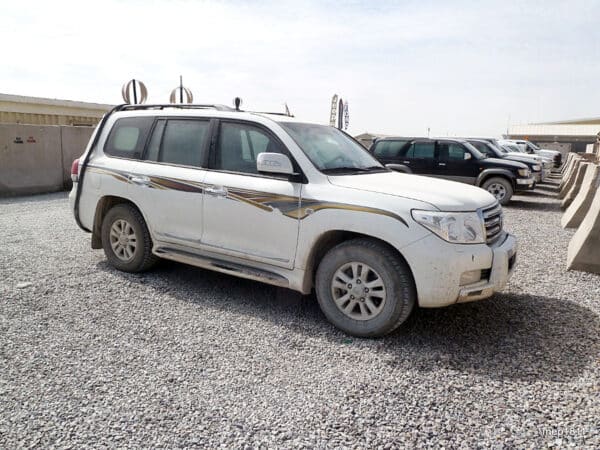In the Global War on Terror, there’s one vehicle marque that stands out, used by both the Islamic extremists and the Western forces who were fighting them: Toyota.
In 2010 and 2013, I had the honor to serve alongside the Third Infantry Division in Iraq and Afghanistan. I was a law enforcement professional, a contractor assigned to advise on identifying, targeting, and actioning the improvised explosive device (IED) bomb makers. I also served as a rule of law advisor, a battlefield investigator, and advised the host country police and intelligence services.
During these tours, I was overwhelmed by the number of Toyota Land Cruisers used by coalition forces, non-governmental organizations, and just all over. There were 100 series, 70 series, 200 series, and Hilux trucks.
Virtually all of these trucks were up-armored, meaning that they were armored to withstand 7.62 munitions, as well as to offer protection against IEDs. The armoring consisted of ballistic panels in the doors, roof, floor, and engine compartment.

The tires were fitted with run-flat inserts, and the glass was replaced with ballistic glass and polycarbonate windows a couple of inches thick.

Some of the trucks were also fitted with gun ports in the doors and/or windows, and some with a roof hatch for a gunner. Many trucks also had a “Trunk Monkey” option. This variant fitted a rear facing seat in the cargo area for a gunner to cover the rear of the vehicle.

Most of the vehicles were fitted with ARB bumpers and roof racks. The roof racks held the spare tire, while the bumpers were fitted with communications antennae and a winch. Fixed to the front and rear recovery points were tow straps coiled up and zip tied to the ARBs and tucked inside the rear door, ready for immediate deployment. Many were also equipped with red/blue strobe lights and sirens.
Depending on the truck’s role, the interiors might be stock or heavily modified for mission-essential use. Like the “Trunk Monkey” option, rear seats were sometimes replaced with side-facing seats for better access to the doors.

In defensive situations in vehicles without gun ports, the doors would be cracked open, and defensive fire directed from the vehicle. Front seat backs would have pouches containing extra weapons, magazines, and trauma kits. Most trucks carried large floor jacks for the fastest possible tire changes.
The dashboard would typically have a video camera and navigation aids. U.S./NATO vehicles would navigate using a Blue Force Tracker (BFT), allowing the truck commander to see other friendly forces as well as known enemy locations. The BFT were also used in navigation and allowed tracking of all friendly vehicles by the local tactical operations center. The console area would be filled with radio equipment.

Bristling from these trucks were a myriad of aerials. Some were for radio communications (COMMS), BFT, satellite communications, and electronic countermeasures (ECM) to defeat IEDs.
ECMs are devices that block or jam radio frequencies that certain IEDs use to detonate. One of the drawbacks of the 200 series Land Cruisers with all its electronics was that ECM gear would often interfere with the operation of the electronic remote and keyless start.

Except for the Hiluxes, the Land Cruisers were usually used for VIP movements. Seeing a civilian Afghan or Iraqi in a Land Cruiser usually meant that person was some sort of big shot.
The Hiluxes, along with some Tacomas, were often used by Special Forces. These double-cab trucks were armored, lifted, and fitted with mounts for a M249 Squad Automatic Weapon, M240 general-purpose machinegun, or a 40mm grenade launcher.

COMMS antennas were also fitted infrared light for night vision goggle use.
While at Kandahar Airfield, I spotted an Arctic Trucks-built Land Cruiser that belonged to the Lithuanian special forces. This Arctic Truck was armored with gun ports in the doors, a truly remarkable vehicle.
In talking with many different people and having driven an armored Land Cruiser while stationed in Peru, the consensus was that Land Cruisers were the best platform for an armored vehicle. They were rugged enough to handle the extra weight and were reliable. There were also a couple of Suburbans, Expeditions, Land Rovers, Nissan Patrols, and a couple of G-wagons, but Toyota Land Cruisers were in the majority.

Toyotas played a significant role in civilian and insurgent life. When outside the confines of my base, the streets were filled with Toyota Hiluxes, minivans used as buses and sedans. We also saw the Toyota trucks being used by the various terrorist groups.

If there’s one common thread running throughout low level conflicts in various sh*thole countries, it’s the presence of vehicles produced by Kiichiro Toyoda’s company.

NEXT STEP: Download Your Free Target Pack from RECOIL
For years, RECOIL magazine has treated its readers to a full-size (sometimes full color!) shooting target tucked into each big issue. Now we’ve compiled over 50 of our most popular targets into this one digital PDF download. From handgun drills to AR-15 practice, these 50+ targets have you covered. Print off as many as you like (ammo not included).
Get your pack of 50 Print-at-Home targets when you subscribe to the RECOIL email newsletter. We’ll send you weekly updates on guns, gear, industry news, and special offers from leading manufacturers – your guide to the firearms lifestyle.
You want this. Trust Us.
Read the full article here




![[FIRST LOOK] Strike Industries EMP With LED [FIRST LOOK] Strike Industries EMP With LED](https://gundayfunday.com/wp-content/uploads/2024/12/SI-EMP-3-390x220.jpeg)
